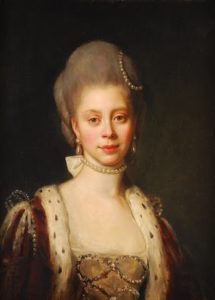
Queen Charlotte of England, 1863 portrait
*Princess Sophie Charlotte was born on this date in 1744. She was the second Black Queen of England. Philippa of Hainault was the first Black Queen of England.
Charlotte was the eighth child of the Prince of Mirow, Germany, Charles Louis Frederick, and his wife, Elisabeth Albertina of Saxe-Hildburghausen. In 1752, when she was eight years old, Sophie Charlotte's father died. As princess of Mecklenburg-Strelitz, Sophie Charlotte was descended directly from an African branch of the Portuguese Royal House, Margarita de Castro y Sousa. Six different lines can be traced from Princess Sophie Charlotte to Margarita de Castro y Sousa.
George I of Great Britain’s grandmother was Elizabeth Stuart, The Winter Queen of Bohemia and the daughter of James VI of Scotland and James I of England and Great Britain. George I was the grandfather of Charlotte's eventual husband (George III). As a Protestant and a descendant of the Stuart Kings, he was chosen to become king. The long lineage of Scottish kings and queens is often sidelined in the ancestry of the current royal family.
She married George III of England on September 8, 1761, at the Chapel Royal in St James’s Palace, London, at 17, becoming the Queen of England and Ireland. The marriage contract conditions were, ‘The young princess, join the Anglican church and be married according to Anglican rites, and never involve herself in politics.’ Although the Queen was interested in what was happening in the world, especially the war in America, she fulfilled her marital agreement. The Royal couple had fifteen children, thirteen of whom survived to adulthood. Their fourth eldest son was Edward Augustus, Duke of Kent, who later fathered Queen Victoria.
Queen Charlotte made many contributions to Britain as it is today, though the evidence is not obvious or well publicized. Her African bloodline in the British royal family is not common knowledge. Portraits of the Queen had been reduced to fiction of the Black Magi until two art historians suggested that the definite African features of the paintings derived from actual subjects, not the minds of painters.
In Queen Charlotte’s era, slavery was prevalent, and the anti-slavery campaign was growing. Portrait painters of the royal family were expected to play down or soften Queen Charlotte's African features. Painters such as Sir Thomas Lawrence, who painted Queen Charlotte in the autumn of 1789, had their paintings rejected by the royal couple, who were not happy with the representations of the likeness of the Queen. These portraits are among those available to view now, which could be seen as continuing the political interests of those who disapprove of a multi-racial royal family in Britain.
Sir Allan Ramsey produced the most African representations of the Queen and was responsible for the majority of the paintings of the Queen. Ramsey’s inclination to paint truer versions of the Queen could have come from being ‘an anti-slavery intellectual of his day. The Coronation painting by Ramsey of the Queen was sent out to the colonies/commonwealth and played a subtle political role in the anti-slavery movement. Johann Zoffany also frequently painted the Royal family in informal family scenes.
Queen Charlotte was a learned woman; her letters indicate she was well-read and interested in the fine arts. The Queen is known to have been supported by and taught music by Johann Christian Bach. She was extremely generous to Bach’s wife after Bach’s death. Wolfgang Amadeus Mozart, at age eight, dedicated his Opus 3 piece to the Queen at her request. Also an amateur botanist, Queen Charlotte helped to establish Kew Gardens, bringing, amongst others, the Strelitzia Reginae, a flowering plant from South Africa. The Queen, who had the first one in her house in 1800, introduced the Christmas tree to England. It was said to be decorated with ‘sweetmeats, almonds, and raisins in papers, fruit, and toys. Also, the Queen Charlotte Maternity Hospital was established in London. It is set up as a charitable institution, England's oldest maternity care institution.
Queen Charlotte died on November 17, 1818, at Dutch House in Surrey, now Kew Palace, in the presence of her eldest son, the Prince Regent. She is buried at St George’s Chapel, Windsor. The only private writings that have survived are Queen Charlotte's 444 letters to her closest confidant, her older brother, Charles II, Grand Duke of Mecklenburg-Strelitz. On May 23 1773, in a letter, the Queen felt she was in a position of privilege yet a task. Her Christian faith was a protection and a method of endurance, as she quotes from the Bible and recognizes her role as a royal of God beyond her royal role on earth. An exhibition took place 2004 at the Queen’s Gallery, Buckingham Palace, displaying Charlotte and George’s collections and tastes in the arts.
Queen Charlotte was the four-time great-grandmother of the present Queen Elizabeth II, who still lives in the expanded Buckingham House, now Buckingham Palace. Kew Gardens still flourishes and is constantly being developed; the Queen Charlotte maternity hospital and many other places still carry her name in honor globally, such as Charlotte town, Canada, and Fort Charlotte, St Vincent, West Indies.